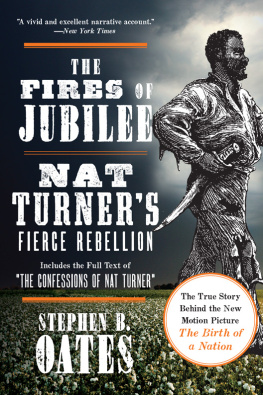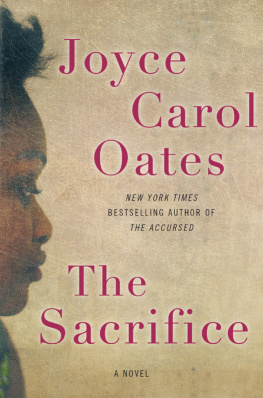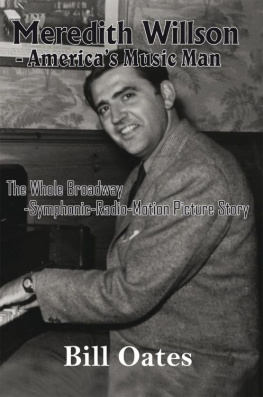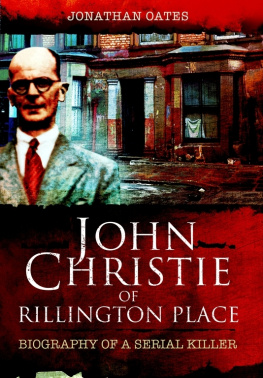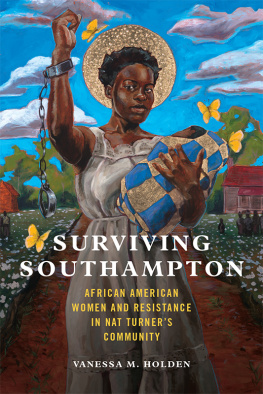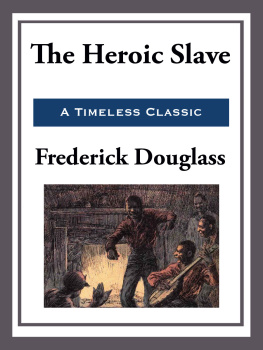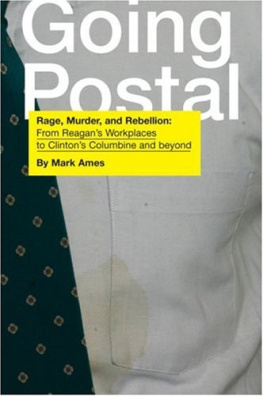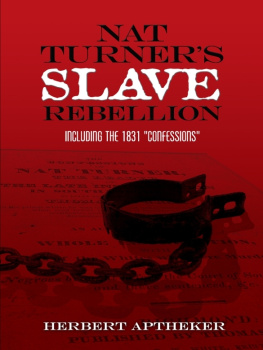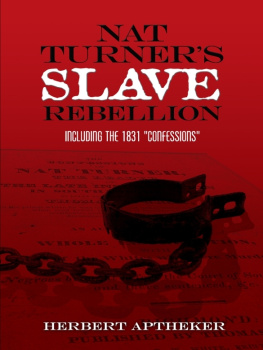Oates - The fires of jubilee: nat turners fierce rebellion
Here you can read online Oates - The fires of jubilee: nat turners fierce rebellion full text of the book (entire story) in english for free. Download pdf and epub, get meaning, cover and reviews about this ebook. year: 2014;2016, publisher: HarperCollins e-Books, genre: Detective and thriller. Description of the work, (preface) as well as reviews are available. Best literature library LitArk.com created for fans of good reading and offers a wide selection of genres:
Romance novel
Science fiction
Adventure
Detective
Science
History
Home and family
Prose
Art
Politics
Computer
Non-fiction
Religion
Business
Children
Humor
Choose a favorite category and find really read worthwhile books. Enjoy immersion in the world of imagination, feel the emotions of the characters or learn something new for yourself, make an fascinating discovery.
- Book:The fires of jubilee: nat turners fierce rebellion
- Author:
- Publisher:HarperCollins e-Books
- Genre:
- Year:2014;2016
- Rating:4 / 5
- Favourites:Add to favourites
- Your mark:
- 80
- 1
- 2
- 3
- 4
- 5
The fires of jubilee: nat turners fierce rebellion: summary, description and annotation
We offer to read an annotation, description, summary or preface (depends on what the author of the book "The fires of jubilee: nat turners fierce rebellion" wrote himself). If you haven't found the necessary information about the book — write in the comments, we will try to find it.
The fires of jubilee: nat turners fierce rebellion — read online for free the complete book (whole text) full work
Below is the text of the book, divided by pages. System saving the place of the last page read, allows you to conveniently read the book "The fires of jubilee: nat turners fierce rebellion" online for free, without having to search again every time where you left off. Put a bookmark, and you can go to the page where you finished reading at any time.
Font size:
Interval:
Bookmark:
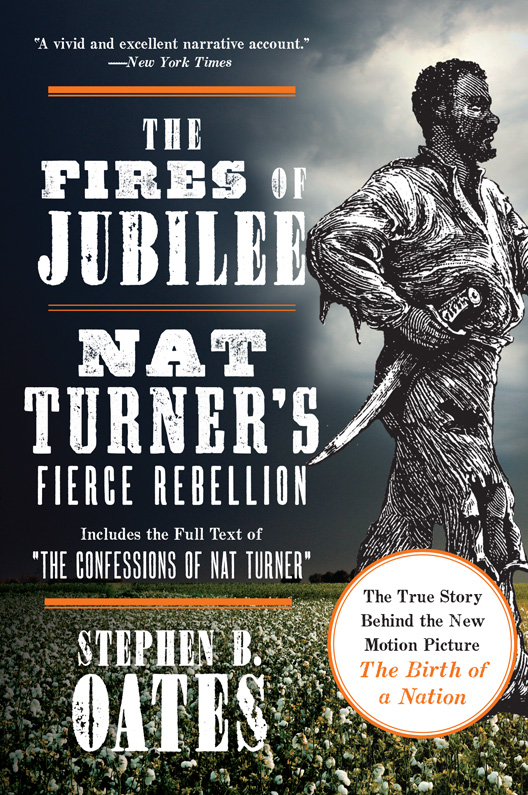
When questioned as to the manner of manufacturing those different articles, he was found well informed on the subject.
The committing Magistrate.
For my mother and my father
At this moment, I saw more clearly than ever the brutalizing effects of slavery upon both slave and slaveowner.
F REDERICK D OUGLASS
If our work has any final value, that value must depend very largely on our ability to see the essential truth beyond the darkness and the error... to perform the historians difficult task not only with the historians competence but also with the skill, the insight and the demanding conscience of the literary artist.
B RUCE C ATTON
He is the most famous slave insurgent in American history, the victim of a violent system who struck back with retributive violence. His rebellion illustrates a profound truth. As Lerone Bennett says, Nat Turner reminds us that oppression is a kind of violence which pays in coins of its own minting. He reminds us that the first and greatest of all gospels is this: that individuals and systems always reap what they sow.
When I wrote this biography of Nat, I tried to tell his story with empathy and accuracy. Through the technique of dramatic narration, I wanted to transport readers back to Nats time so that they might suffer with him and see the world of slavery and the Old South through his eyes. That way they might gain melancholy insight into what it was like to be a slave. They might appreciate Nat for the complex, paradoxical figure he was, a man capable of love and hatred, doubt and thundering visions, sensitivity and messianic rage. They might understand why Nat finally chose the sword as his instrument of liberation, and why he set out to fulfill the injunction in Exodus that thou shalt give life for life, eye for eye, tooth for tooth, hand for hand, foot for foot, burning for burning. By placing Nat and his revolt in proper historical context, I hoped to convey how the insurrection shocked the slave South to its foundations, exacerbated sectional tensions, and pointed the way to the Civil War thirty years later.
I also included an epilogue about my pilgrimage to Southampton County in 1973; in it, I sought to demonstrate that a good deal more goes into biography than reading documents and books in a library. The epilogue has an artistic purpose, too, for it attempts to show that past and present really are a continuum. In fact, the last scene of the epilogue circles back thematically to 1832 and reveals a sad truth about the durability of human prejudice. In 1832, a Virginia newspaper editor, in defending gradual emancipation and colonization over immediate manumission, argued that whites could not overcome their racial hostilities overnight. In the epilogue, I quoted a Virginia banker who said the same thing in 1973.
I also noted what little Virginia officialdom had then done to commemorate Nats rebellion. Since 1973, things have gotten worse. The local historical marker about Nat described in the epilogue, a sign that once stood along Highway 58 in Southampton County, is no longer there. And the old homes that figured in the rebellion, the ones I visited in 1973 and wrote about in the epilogue, are gone as well. Clearly Nat Turner is not someone the local and state establishments want to remember. Yet Nats spirit is still alive in Southampton County, in the legends and folklore of local blacks. I like to think that Nat also lives in The Fires of Jubilee and that this is one of the reasons the book has remained in print.
On the wall of my study, I keep a likeness of Nat, along with photographs of John Brown, Abraham Lincoln, and Martin Luther King, Jr.the subjects of three of my other biographies. For me, the four lives are all of a piece: They form a biographical quartet centered around the greater Civil War era and its century-old legacies. All four of my subjects were driven, visionary men, all were absorbed in the issues of slavery and race, and all devised their own solutions to those inflammable problems. And all perished, too, in the conflicts and hostilities that have surrounded the quest for freedom and equality in this country. While The Fires of Jubilee can be read entirely on its own, it is part of a larger biographical design.
Some seventy miles below Richmond, in the southeastern part of Virginia along the North Carolina border, lay a little-known backwater called Southampton County. It was a rolling, densely forested area, with farms, plantations, and crossroad villages carved out of the woods. In 1831 most of the farms and smaller plantations were hardly distinguishable from one anotherthe houses were charmless, two-story rectangles, surrounded by haystacks and corn and cotton patches. Around the big house were various satellite sheds, a one-room kitchen, a barn, and maybe some slave cabins. Out in back were pungent outhouses poised on the edge of a slope or a steep ravine. A typical homestead had a menagerie of dogs, chickens, hogs, cows, mules, and maybe a couple of horses. And it had an apple orchard, too, for the succulent fruit not only commanded a fair price at market, but was the source of Southamptons most cherished productan apple brandy potent enough to make a sailor reel. Not a homestead was complete without a brandy still, and the countys most popular citizens were those with well-stocked cellars.
The county seat or county town was Jerusalem, a smoky cluster of buildings where pigs rooted in the streets and old-timers spat tobacco juice in the shade of the courthouse. Consisting of some 175 souls, Jerusalem lay on the forested bank of the Nottoway River some fifty or sixty miles from Norfolk and the Atlantic Ocean. To the west of Jerusalem was Bethlehem Crossroads and to the southwest a loose cluster of homesteads called Cross Keys. Such villages were the nerve centers of Southamptons social lifehere on Sundays and holidays white families gathered to hear preaching, dance to fiddles, enjoy a communal barbecue, joke, gossip, cheer on a shooting match or a horse race, get drunk, talk about the weather or argue about politics in their distinct Virginia accent (hoose for house). Most political discussions focused on local issues, for Southampton had no newspapers of its own and people here lived in considerable isolation from the outside world. What news they received came mainly from travelers and express riders, who brought mail in from Petersburg, Norfolk, and Murfreesboro down in North Carolina.
Although Southampton was a remote, generally lackluster neighborhood, it did have a planter class and in that respect was no different from most other Southern tidewater communities. If you had to own at least 20 slaves to rank as a planter, then 96 of Southamptons 734 slaveholdersabout 13 percentcould claim that coveted distinction. Some fifteen men, with names like Newsom, Worrell, and Briggs, owned fifty slaves or morewhich theoretically classified them as aristocrats. And Thomas Ridley, old man Urquhart, and John Kelly possessed large plantations with 145 to 179 Negroes apiece, which, in terms of slave wealth, placed them among the Old Souths elite. Evidently these backwater squires had inherited or married into most of their possessions and had bought the rest. Some enterprising fellows had even constructed homes that were impressive by Southampton standardswith columned front porches and imported fineryand now found themselves hard-pressed to meet their mortgage payments. Still, Southamptons large planters lacked the tradition and prestigeand the majestic, landscaped mansionsthat characterized Virginias established gentry, especially the patricians along the great tidewater rivers in the more eastern and northeastern counties.
Font size:
Interval:
Bookmark:
Similar books «The fires of jubilee: nat turners fierce rebellion»
Look at similar books to The fires of jubilee: nat turners fierce rebellion. We have selected literature similar in name and meaning in the hope of providing readers with more options to find new, interesting, not yet read works.
Discussion, reviews of the book The fires of jubilee: nat turners fierce rebellion and just readers' own opinions. Leave your comments, write what you think about the work, its meaning or the main characters. Specify what exactly you liked and what you didn't like, and why you think so.

